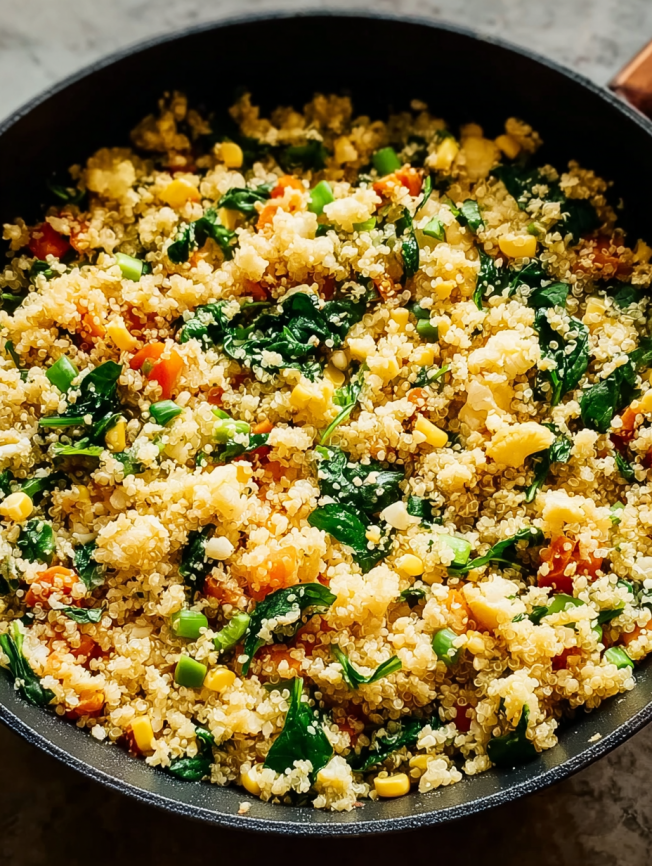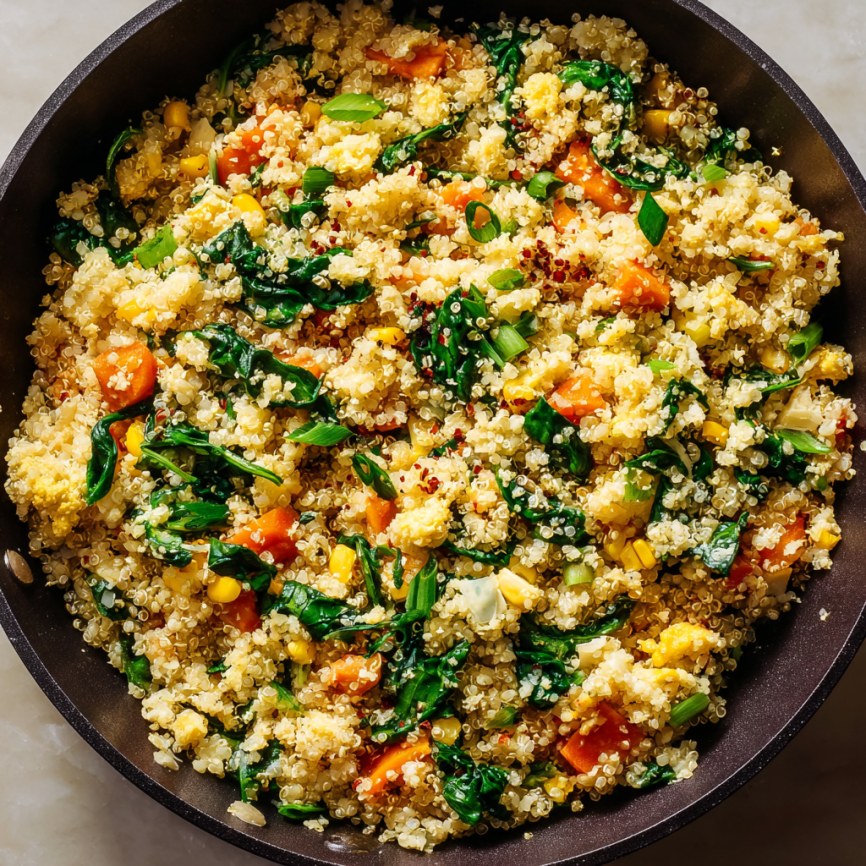I’ll be honest – when I first heard about cauliflower rice, I was skeptical. How could a vegetable possibly replace one of my favorite comfort foods? However, after one perfectly seasoned batch, I became a complete convert. This simple transformation turns humble cauliflower into fluffy, rice-like grains that soak up flavors beautifully while delivering incredible nutrition. Now, it’s become my secret weapon for creating satisfying, healthy meals that don’t leave me feeling deprived.
Why You’ll Love This Healthy Rice Alternative
Nutritional Powerhouse in Disguise
Traditional white rice provides mostly empty calories and simple carbohydrates. In contrast, cauliflower rice delivers impressive nutrition with just a fraction of the calories. Each serving contains abundant vitamin C for immune support, vitamin K for bone health, and folate for cellular function. Additionally, the fiber content helps stabilize blood sugar levels and promotes digestive wellness.
Incredible Versatility
One of cauliflower rice’s greatest strengths is its chameleon-like ability to adapt to any cuisine. Whether you’re making Asian stir-fries, Mediterranean grain bowls, Mexican burrito bases, or Indian curries, this neutral-tasting substitute absorbs surrounding flavors while providing satisfying bulk to meals.
Diet-Friendly Champion
This recipe works beautifully for multiple dietary approaches. Keto followers love its extremely low carb count, while paleo and Whole30 participants appreciate its clean, whole-food nature. Furthermore, it’s naturally gluten-free, vegan, and fits seamlessly into weight management plans without sacrificing meal satisfaction.
Quick and Convenient
Unlike traditional rice that requires 20-30 minutes of cooking time, cauliflower rice is ready in under 10 minutes. This makes it perfect for busy weeknights when you need healthy side dishes fast.
Simple Ingredients for Perfect Results
The Star Ingredient
- 1 large head of cauliflower – Choose firm, white heads without dark spots
- 1 tablespoon olive oil – Provides cooking medium and subtle flavor
- Salt, to taste – Essential for enhancing natural flavors
- Pepper, to taste – Adds gentle warmth and complexity
Optional Flavor Boosters
- Minced garlic – Creates aromatic depth
- Chopped fresh parsley – Brings brightness and color
- Fresh lemon zest – Adds citrusy freshness and Mediterranean flair
Step-by-Step Preparation Guide
Preparing the Cauliflower
Start by removing all leaves and the tough core from your cauliflower head. Cut the remaining florets into roughly equal-sized pieces – this ensures even processing. Don’t worry about perfection; the food processor will handle the rest.
Creating Rice-Like Texture
Place the cauliflower florets into your food processor and pulse in short bursts until the pieces resemble rice or couscous grains. Avoid over-processing, which creates a mushy texture instead of distinct grains. Work in batches if necessary to achieve uniform results.
The Perfect Sauté
Heat olive oil in a large skillet over medium heat until it shimmers slightly. Add the processed cauliflower rice and spread it evenly across the pan. Sauté for 5-7 minutes, stirring occasionally to prevent sticking and ensure even cooking.
The cauliflower should become tender but still maintain some texture – never mushy or waterlogged. You’ll know it’s ready when it looks fluffy and feels tender when pierced with a fork.
Seasoning for Success
Remove the pan from heat and immediately season with salt and pepper. This is also the perfect time to add any optional ingredients like minced garlic, fresh parsley, or lemon zest. Taste and adjust seasonings as needed.
Creative Serving Suggestions
International Inspirations
Transform your cauliflower rice into global favorites by adjusting seasonings. For Asian dishes, add sesame oil and soy sauce. Mexican-inspired meals benefit from cumin, lime juice, and fresh cilantro. Meanwhile, Mediterranean versions shine with olive oil, lemon juice, and fresh herbs.
Complete Meal Ideas
Use cauliflower rice as the foundation for protein bowls topped with grilled chicken, salmon, or tofu. It also works wonderfully in stuffed peppers, as a base for curry dishes, or mixed into soups for added nutrition and thickness.
Breakfast Applications
Don’t limit cauliflower rice to lunch and dinner! It makes an excellent base for breakfast bowls topped with eggs, avocado, and fresh herbs. You can also incorporate it into frittatas or breakfast casseroles for extra vegetables.

Delicious Recipe Variations
Herbed Cauliflower Rice
Enhance the basic recipe with fresh herbs like thyme, rosemary, or oregano. Add them during the last minute of cooking to preserve their vibrant flavors and colors.
Coconut Curry Version
Replace olive oil with coconut oil and add curry powder, turmeric, and a splash of coconut milk for an exotic twist that pairs perfectly with Indian-inspired dishes.
Lemon Garlic Style
Sauté minced garlic in the oil before adding cauliflower rice, then finish with fresh lemon juice and zest for a bright, Mediterranean flavor profile.
Spicy Southwestern
Add chili powder, cumin, and paprika during cooking, then finish with lime juice, diced jalapeños, and fresh cilantro for a bold, Mexican-inspired side dish.
Storage and Meal Prep Tips
Proper Storage Techniques
Cooked cauliflower rice keeps beautifully in the refrigerator for up to 4 days when stored in airtight containers. Let it cool completely before refrigerating to prevent condensation, which can make it soggy.
Freezing Guidelines
Raw cauliflower rice freezes excellently for up to 3 months. Spread it on baking sheets to freeze individually before transferring to freezer bags. Cooked versions can also be frozen but may have slightly softer texture upon thawing.
Reheating Methods
Reheat refrigerated cauliflower rice in a skillet over medium heat with a tiny bit of oil, stirring frequently. Microwave reheating works too – use 30-second intervals and stir between to ensure even heating.
Essential Tips for Success
Equipment Matters
A food processor produces the most consistent results, but you can also use a box grater if needed. Some people prefer using the large holes of a cheese grater for more control over texture.
Moisture Management
Cauliflower naturally contains moisture, so avoid covering the pan while cooking unless you want a softer texture. For fluffier results, cook uncovered and let any excess moisture evaporate.
Batch Cooking Strategy
Process large batches of raw cauliflower rice on weekends and store portions in the freezer. This makes weeknight meal preparation incredibly quick and convenient.
Important Notes for Perfect Results
Texture Preferences
Some people prefer their cauliflower rice with more bite, while others like it completely tender. Adjust cooking time based on your preference, but remember that overcooking leads to mushy results.
Salt Timing
Season cauliflower rice after cooking rather than before. Salt draws out moisture, which can make the final product watery instead of fluffy.
Quality Selection
Choose fresh, firm cauliflower heads for best results. Avoid heads with brown spots, soft areas, or yellowing, as these indicate age and will affect both flavor and texture.

Frequently Asked Questions
Can I make cauliflower rice without a food processor?
Yes! You can grate cauliflower using the large holes of a box grater. This method takes more effort but produces similar results. Alternatively, finely chop the florets with a sharp knife, though this won’t create as uniform a texture.
Why does my cauliflower rice turn out watery?
Excess moisture is usually the culprit. Make sure to cook uncovered so steam can escape, and avoid overcrowding the pan. Also, don’t add salt until after cooking, as it draws out moisture during the cooking process.
Can I eat cauliflower rice raw?
Absolutely! Raw cauliflower rice works wonderfully in cold salads, grain bowls, or as a base for raw food dishes. Just season it well and let it sit for a few minutes to absorb flavors.
How do I prevent cauliflower rice from getting mushy?
Cook it over medium heat and don’t stir too frequently. Also, avoid overcooking – it should be tender but still have some texture. Finally, let any excess moisture evaporate by cooking uncovered.
Can I use frozen cauliflower to make cauliflower rice?
While fresh is ideal, frozen cauliflower florets can work. Thaw them completely and pat dry before processing. However, the texture may be slightly softer than using fresh cauliflower.
What’s the best way to season cauliflower rice?
Start with salt and pepper, then build flavors based on your intended use. Garlic, herbs, citrus zest, and spices all work beautifully. Season after cooking for best results.
How much regular rice does cauliflower rice replace?
Generally, one large head of cauliflower produces about 4 cups of cauliflower rice, which is equivalent to about 2 cups of cooked regular rice in terms of volume and serving size.
Can I make cauliflower rice ahead of time?
Yes! You can process raw cauliflower up to 3 days ahead and store it in the refrigerator. Cooked cauliflower rice keeps for 4 days and reheats beautifully.
Prep Time: 10 minutes | Cooking Time: 7 minutes | Total Time: 17 minutes
Calories: 100 kcal per serving | Servings: 4 generous portions
This simple Cauliflower Rice recipe opens up a world of healthy, satisfying meal possibilities. Whether you’re cutting carbs, increasing vegetable intake, or simply looking for quick, nutritious side dishes, this versatile substitute delivers on flavor, nutrition, and convenience. Once you master this basic technique, you’ll find yourself reaching for cauliflower rice again and again as your go-to healthy grain alternative.

